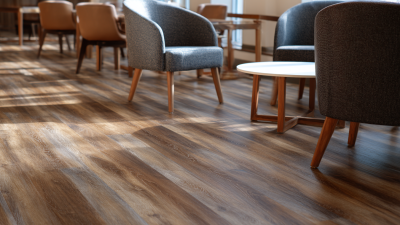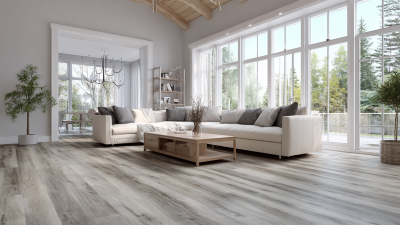When it comes to selecting the perfect flooring for your home, Stone Plastic Composite (SPC) flooring has emerged as a game-changing option, blending durability, aesthetics, and affordability like never before. This innovative flooring material, composed of a mixture of limestone and polyvinyl chloride (PVC), offers remarkable benefits that make it an ideal choice for both residential and commercial spaces. In this ultimate guide, we will delve into the essential factors to consider when choosing Stone Plastic Composite Flooring, including its unique properties, installation methods, maintenance requirements, and design versatility. By equipping yourself with the right knowledge, you can make an informed decision that not only enhances the beauty of your home but also provides lasting value. Whether you’re remodeling a single room or undertaking a full renovation, understanding SPC flooring will empower you to achieve a stunning and functional space.

Stone Plastic Composite (SPC) flooring is rapidly becoming a popular choice for homeowners looking for durability and style. One of its key features is its exceptional resistance to moisture, making it ideal for areas prone to spills and humidity, such as kitchens and bathrooms. Unlike traditional wood flooring, SPC does not warp or swell when exposed to water, providing peace of mind for homeowners. Additionally, its sturdy core structure adds an element of stability, allowing it to withstand heavy foot traffic without showing wear and tear.
Another benefit of SPC flooring is its ease of installation and maintenance. Most SPC products come with a click-lock design, enabling a straightforward DIY installation process that can save both time and money. Maintenance is equally simple, requiring only regular sweeping and occasional mopping to keep the surface looking fresh. Furthermore, SPC offers a wide array of designs and finishes, allowing homeowners to achieve the desired aesthetic while enjoying the practicality of a robust flooring option. With its combination of resilience, simplicity, and style, SPC flooring is an excellent investment for any home.

When assessing the durability of Stone Plastic Composite (SPC) flooring, it’s essential to consider various industry standards and performance metrics. SPC flooring is known for its robust construction, typically featuring a stone-plastic core that resists moisture and impacts. The thickness of the wear layer is a crucial factor; a thicker wear layer generally signifies better resistance to scratches and dents, making it ideal for high-traffic areas in your home.
Tips: When selecting SPC flooring, look for products with an AC (Abrasion Class) rating. Higher AC ratings indicate better durability, especially for residential and commercial spaces. Additionally, pay attention to the manufacturer’s warranty, as a longer warranty often reflects confidence in the flooring's longevity.
Testing for performance metrics can also provide insight into the flooring’s resilience. This includes assessments of dimensional stability, water resistance, and thermal stability. SPC flooring that scores well on these tests can be a sustainable choice for various environments, ensuring that your investment lasts for years while retaining its aesthetic appeal.
When considering flooring options for your home, the comparison between Stone Plastic Composite (SPC) flooring and other materials is crucial. SPC flooring stands out primarily due to its impressive longevity, which can range from 10 to 30 years, depending on the quality and usage. According to industry reports, SPC flooring is highly resistant to wear and tear, making it a popular choice for high-traffic areas. In contrast, traditional hardwood or laminate flooring generally has a shorter lifespan and can be more susceptible to water damage, which may lead to more frequent replacements.
Cost is another significant factor. SPC flooring tends to be more budget-friendly than luxury vinyl or hardwood, often priced around $2 to $5 per square foot, compared to hardwood's $5 to $10 range. Moreover, the installation of SPC is generally simpler and can be a DIY project, reducing additional labor costs. Maintenance is relatively low for SPC; it requires minimal upkeep and is easy to clean, unlike carpet or unsealed wood that can harbor allergens and require more intensive maintenance.
**Tips:** When selecting flooring, consider the specific needs of your home. For high-moisture areas like bathrooms, SPC’s water resistance makes it an ideal choice. Moreover, always check for a warranty as reputable brands typically offer 20 to 30 years of coverage, reflecting their confidence in the product's durability.
When installing Stone Plastic Composite (SPC) flooring, following best practices is crucial to achieve a durable and aesthetically pleasing finish. First, it's essential to ensure that the subfloor is clean, dry, and level, as uneven surfaces can lead to problems down the line. According to industry reports, proper preparation can reduce the risk of installation failures by up to 30%, showcasing the importance of this initial step. Using a moisture barrier is also recommended, especially in areas prone to humidity, further safeguarding the integrity of your flooring.
During installation, it’s advisable to acclimate SPC planks to the room's temperature and humidity, which experts suggest should be left for 48 hours prior to installation. This practice minimizes expansion and contraction, which is vital for maintaining the floor’s appearance and performance. Furthermore, professional insights indicate that employing a staggered installation pattern helps in distributing weight more evenly and enhances the visual appeal of the finished floor. By adhering to these guidelines, homeowners can ensure that their SPC flooring not only looks great but also lasts for years to come.
| Dimension | Description | Benefits | Installation Method |
|---|---|---|---|
| Thickness | Typically ranges from 4mm to 8mm | Variety of thicknesses to suit different needs | Floating installation method recommended |
| Wear Layer | Top protective layer, often made of PVC | Increases durability and scratch resistance | Ensure proper alignment during installation |
| Water Resistance | High level of moisture resistance | Ideal for kitchens and bathrooms | Use a vapor barrier for best results |
| Installation Time | Generally low; can be completed in a day | Quick and efficient for home renovations | Follow manufacturer's guidelines for best outcomes |
| Cost | Costs range from $2 to $5 per square foot | Value for money considering durability | Consider total installation costs |
When considering stone plastic composite (SPC) flooring for your home, sustainability is a crucial factor to evaluate. SPC flooring is known for its eco-friendly attributes, as it is composed of natural limestone powder, polyvinyl chloride, and stabilizers, contributing to its durability and low environmental impact. According to a report by the Resilient Floor Covering Institute, SPC flooring typically emits low volatile organic compounds (VOCs), enhancing indoor air quality compared to traditional flooring options. This makes SPC an attractive choice for homeowners who prioritize sustainability.
Tip: Look for SPC flooring products that have been certified by reputable organizations such as GREENGUARD or FloorScore, which assess the standard of indoor air quality and chemical emissions.
Moreover, the lifecycle of SPC flooring is appealing from an ecological standpoint. It requires less energy to produce and is often recyclable at the end of its lifespan. A study from the U.S. Environmental Protection Agency indicates that vinyl flooring, including SPC, has a lower carbon footprint compared to other flooring materials, making it a responsible option for environmentally conscious consumers.
Tip: Consider using SPC flooring in combination with sustainable design practices, such as utilizing renewable resources and improving energy efficiency in your home. This holistic approach helps maximize the ecological benefits of your flooring choice.







